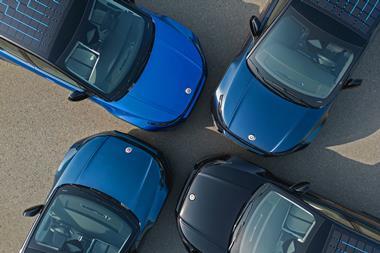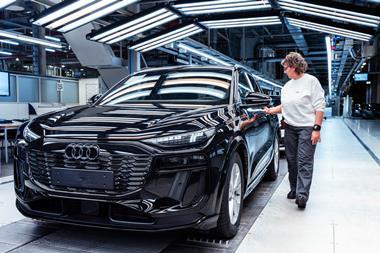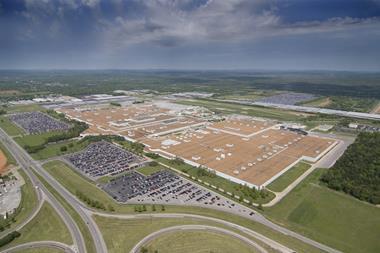
A breakthrough technology for advanced high strength steel coating, the JVD process is demonstrating higher performance with lower environmental impact
 The recent launch of ArcelorMittal’s JVD line at its facility near Liege, Belgium, represents the culmination of years of scientific investigation by its research and development teams.The only one of its kind in the world, the new JVD line delivers multiple advantages associated with this breakthrough technology for the metallic coating of steel, in terms of the even coating, quality of adhesion and diminished environmental impact.
The recent launch of ArcelorMittal’s JVD line at its facility near Liege, Belgium, represents the culmination of years of scientific investigation by its research and development teams.The only one of its kind in the world, the new JVD line delivers multiple advantages associated with this breakthrough technology for the metallic coating of steel, in terms of the even coating, quality of adhesion and diminished environmental impact.
Jetgal is the zinc coating deposited through the jet vapour deposition process (JVD) developed by ArcelorMittal and the CRM Group. A hydrogen-free coating process with the lowest global warming potential of any industrial steel coating method. Suitable for any metallurgy, JVD can be used to coat all future ultra high strength steels.
The technology is significantly more environmentally-friendly than any other coating processes. A lifecycle assessment evaluating the environmental impact of this process as a whole – the coating, the use phase of the products, the waste products and their management – showed a higher yield and lower energy consumption than other coating techniques. Developed in collaboration with the CRM group, JVD technology has the lowest global warming potential – a measure used in lifecycle assessment – of any industrial steel coating process.
It’s a highly flexible process due to its ability to produce different coating thicknesses (one side versus another) and to coat a variety of substrates regardless of their chemical composition.
Multiple applicationsJetgal is the brand name for the JVD zinc coating ArcelorMittal applies to steels for the automotive industry. The process has been specifically developed for advanced high strength steels (AHSS) for cold forming such as Dual Phase, TRIP, MartINsite and Fortiform. It is also future-proofed to ensure it can be applied to any future AHSS ArcelorMittal may develop.
A Jetgal coating provides a homogenous coating (up to 10 µm thick) and avoids AHSS becoming more brittle under the influence of hydrogen. The homogeneity of the coating improves corrosion protection significantly and provides an excellent aspect after cold stamping and painting.
The invention continues the Walloon traditional association with steel coating technology development. The first hot dip galvanising line was commissioned in 1881 in Flémalle and the world’s first electrolytic galvanised steel rolled off the production line in Marchin in 1954.
As the latest milestone, the new JVD line is part of a major 138m euro investment programme within the scope of the 2014 Industrial Plan, an agreement between ArcelorMittal, the Walloon Government, Sogepa (Société de Gestion et de Participations) and the social partners. The JVD project was financed by Sogepa through ARCEO, a joint venture between Sogepa and ArcelorMittal.
More world-firstsAt the WCX17: SAE World Congress Experience in Detroit, ArcelorMittal teams showcased the world’s first five-piece hot-stamped, laser-welded door ring and b-pillar. This breakthrough technology has been incorporated into the Chrysler Pacifica, named the 2017 Utility Vehicle of the Year.
ArcelorMittal and ArcelorMittal Tailored Blanks (AMTB) began co-engineering work with FCA US in 2012. The task was to reduce the weight of the 2017 Chrysler Pacifica while meeting or exceeding crash test requirements and minimising costs to the consumer.
Together, the partners identified the side structure of the vehicle’s body-in-white, specifically the door ring and b-pillar, as the area of most opportunity for weight reduction and improved safety performance for this mainstream, high-volume family vehicle.
The team worked creatively and diligently with FCA US to apply steel technology to a solution that provided ultra high strength and crash energy absorption exactly where both attributes were needed while also delivering weight reduction.
After 36-months, 2,000 engineering hours and approximately 300design iterations, the team agreed on one central concept – the world’s first five-piece hot-stamped laser-welded door ring and b-pillar.
Through the use of a patented and award-winning laser ablation process, the ArcelorMittal was able to combine two high-strength steel grades - Usibor, a hot stamping grade that supports weight reduction in advanced shapes that require higher tensile strength, and Ductibor, an energy-absorbing grade designed specifically to complement Usibor in hot-stamping applications and offer ductility – to better manage the crash energies.
Applications As zinc is applied from a vapour, JVD is the only pure zinc application process which can coat any surface. All current and future steel grades, whatever their alloaying content, can be coated using JVD. As JVD is a hydrogen-free coating process, it avoids delayed cracking of UHSS with UTS >1000 MPa (UHSS)
CharacteristicsThe dimensional feasibility of Jetgal coatings depends on the choice of steel substrate and on the manufacturing route involved. The surface quality obtained meets the most stringent requirements regarding surface topography. Jetgal coating does not change the initial roughness of the substrate; it consists of pure zinc and is therefore ductile, enabling it to withstand large deformations.
Some of the attributes featured in the innovation featured include the successful combination of two hot stamping steel grades, Usibor and Ductibor, with five parts welded, prior to hot stamping, for impervious seams. By combining the door ring and the b-pillar, its a solution that eliminates the need for a costly side structure reinforcement as had been used in the previous model.
Todd Baker, president of ArcelorMittal Tailored Blanks Americas, says: “We know the consumer is looking for three important must-haves in their vehicle – safety, fuel economy and affordability. The outcome of this collaboration – the five-piece door ring and b-pillar - contributes to all three of those areas.”
The partners were able to dramatically reduce the weight of the vehicle by 8.64kg (19lbs) meaning that the innovation could contribute to the 250lb total weight reduction for the Pacifica. Also, the design helped improve the vehicle crash performance, especially for the challenging narrow offset and side impact crash requirements. The Pacifica is the first vehicle in the minivan class to achieve an IIHS 2017 Top Safety Pick Plus award.
In order to meet the production needs for the 2017 Chrysler Pacifica and allow for production expansion to meet additional demand from other automakers for the product, ArcelorMittal invested heavily in the development of a dedicated, state-of-the-art processing facility in Woodstock, Ontario. This facility opened in 2015 and allowed for AMTB to amplify the central innovation and meet the high volume and productivity demands of the mainstream application.
The facility’s current capacity will support the annual production of more than two million hot-stamped, laser-welded blanks using two state-of-the-art continuous ablation and welding systems and a dedicated quality lab. The facility has the ability to further expand to help absorb market demand.

Additionally, the new, more advanced quality inspection system that ArcelorMittal developed is “state-of-the-art” and able to inspect several different key process and product characteristics at the same time ensuring 100 percent inspection of every part. With the new system, AMTB can process over three million weld edges through continuous ablation edge preparation and weld about one to two million hot-stamped laser-welded blanks per year, depending on number of weld seams and shapes.
ArcelorMittal is constantly in a state of technological revolution. It is developing new, advanced high-strength steels and solutions for automotive at a record pace. Steel’s strength has multiplied by almost 10 times over the past 20 years, from 270 to 1700 megapascals tensile strength.
The advancements made enable carmakers to create safer, more fuel-efficient and environmentally friendly vehicles than ever before.
































